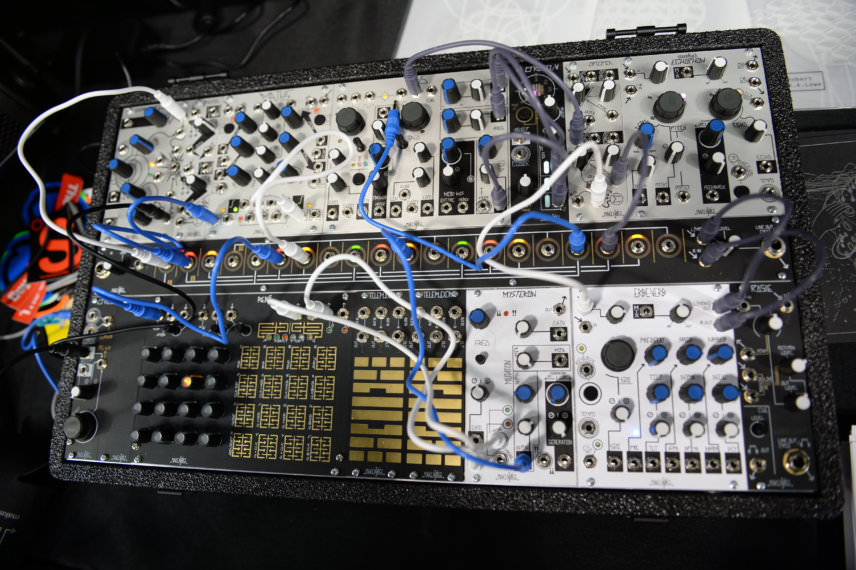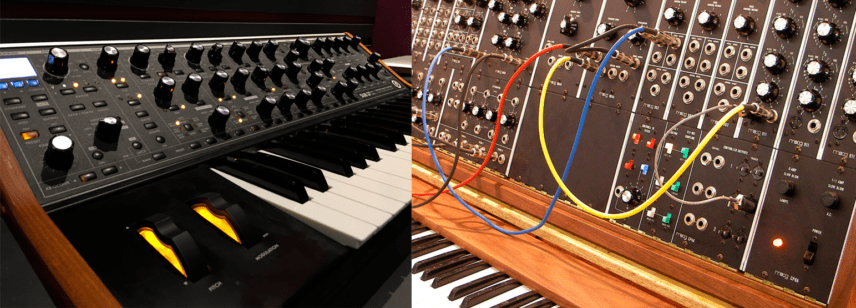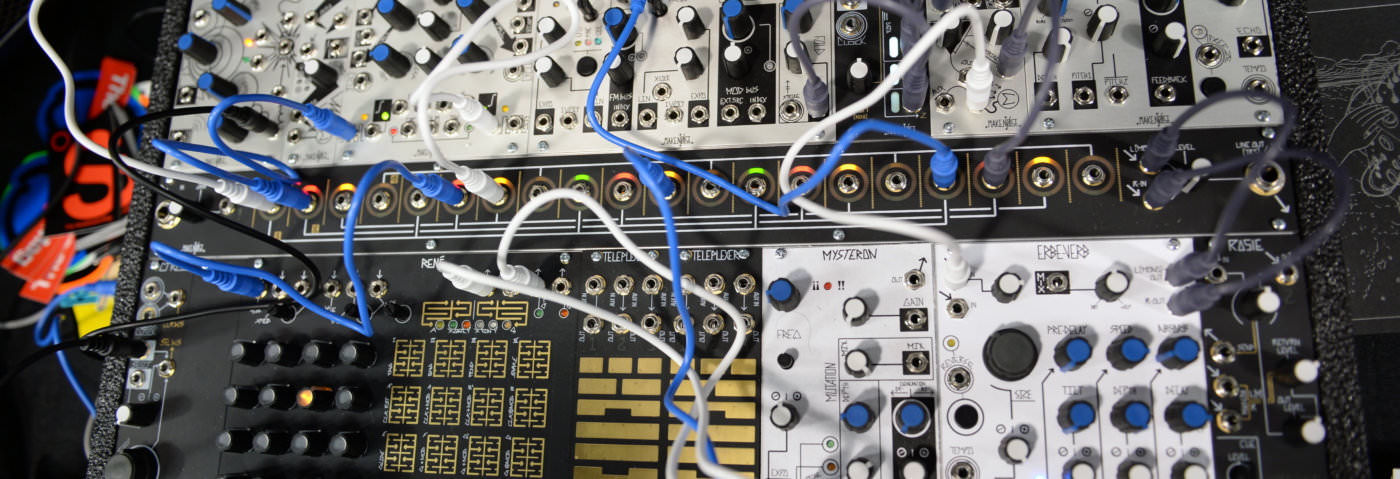In part 1 of our new monthly modular series, LeoMakes starts from the beginning and asks the question, what exactly is a modular synth?
Please bear with me as I make an extraordinarily pedantic statement: a modular synthesizer is a synthesizer made out of (you guessed it) modules.
Modules are electronic circuits that are designed to do specific music-related tasks. For example, there are modules that make sounds (“oscillators”), modules that filter sounds, modules that mix sounds together, and many, many other kinds of modules. There are literally thousands of modules in the world made by hundreds of manufacturers but they generally fall into one of the following categories:
- Oscillators
- Filters
- Amplifiers
- LFOs
- Envelope generators
- Effects
- General utility
This is not an exhaustive list and don’t worry if you don’t know what all these words mean yet. We’ll get into that in due time. The big idea here is that there are a lot of modules that break down into categories of products.

Modules are a lot like LEGO blocks. You can freely connect them as you wish and in doing so build really interesting things that bring you endless joy. Contrary to popular belief, you don’t need a lot of modules to create really amazing sounds. You can do a lot even if you only have a small number of modules and, as your collection of modules inevitably grows, you will be able to create more and more complex and interesting sounds.
OK, so what’s with all the cables?
The modules in a modular synth cabinet are not internally connected to each other*. This means that the system cannot make any sounds until you connect the modules using patch cables. These cables simply connect or “patch” an output of one module to an input of another.
Fun trivia: Synthesizer preset sounds are still commonly called “patches” by end users and manufacturers even though most hardware/software synthesizers have no patch cables at all.
This brings us to a critical difference between modular and non-modular synthesizers: Whereas traditional, non-modular synthesizers usually have one (or a small number of) predetermined routing options, a modular synth lets you connect your modules any way you like. As long as you have the right modules, you can patch up your modular synth to behave just like a classic synth (like a Minimoog) or go nuts and create a crazy, complex signal flow that has never existed before in a commercial product—it’s completely up to you. This can be daunting to some users that are used to working with preset patches, but this flexibility is incredibly powerful for those of us that love sound design!

* There may be special exceptions where modules are internally connected, but in general modules are not connected.
The Sonic Possibilities Grow Exponentially:
Since modules are connected with patch cables and work together, each new module not only adds one new “thing” to your system but also breathes new life into all of your existing modules. For example, if you feel that you’ve explored the limits of your current system and your sonic experiments are sounding “stale” adding even one new module in the mix can make your entire system feel fresh and new again. This is because that one new module can open up possibilities with your existing modules that didn’t exist before. This is very different from traditional (non-modular) synthesizers where you cannot simply add a new filter or oscillator when desired. With non-modular hardware, you are stuck with whatever building blocks and routings the manufacturer provided for you.
Each new module not only adds one new module to your system but can also breathe life into all of your existing modules as well.
What exactly goes through all those cables?
In a word: electricity. The cables carry low-voltage electrical signals that are no different than any of the other cables in your studio. Inside a modular synthesizer, there are two types of signals that can be sent (audio signals and control voltage) but—at their core—both types of signals are nothing more than electrical voltages.
Let’s take a quick look at each signal type:
- Audio Signals: These are “musical” signals that you can listen to if you connect them to a powered speaker. These signals are similar to what comes out of any line-level output, like the outputs of your audio interface that you connect to your studio monitors. In a modular synth, if you send the output of an oscillator module into a filter module, you are sending the sonic output of the oscillator to the filter for further processing.
- Control Voltage (“CV”): These are “non-musical” (and often inaudible) electrical signals that are used to trigger and automate various parameters of modules. In other words, CV is simply a way of getting modules to “talk” to each other using electrical voltages. For example, let’s say you want to automate the sweep of a filter using an ADSR envelope module. You can do this by connecting the ADSR’s output to a CV-input on the filter module. Doing so would let the ADSR module control the filter automatically without you having to physically turn the filter cutoff knob by hand. You won’t hear the actual CV signal itself, but you will hear the effect of the CV signal on the audio signal path.
Control Voltage can be sub-divided down into two categories, but we can go into detail in the next article. All that we need to know here is that there are two kinds of signals (Audio and CV) and both of them are nothing more than electrical voltages flowing through a cable. Simple!
Unlike audio signals, CV signals are not musical and one would usually hear nothing if such signals were connected to powered speakers.
Conclusion:
I think this is a good place to stop with this introductory article. We’ve covered the basics of modular synthesis and learned the following:
- Modular Synthesizers are synthesizers created from… well… modules!
- Modules are electrical circuits that process sounds in weird and wonderful ways
- You get to choose what modules to buy for your system and there are lots of options
- You decide how the modules connect to each other in order to build your sound
- Modules “talk” to each other using two kinds of signals: audio and control voltage (CV). These signals are nothing more than electrical voltages going over a cable.
Now that we’ve covered the absolute basics, we’re free to go into more detail! In the next article, we’ll talk about different form factors of modular synthesizers, i.e “Eurorack/3U” vs “Serge/4U” vs “Moog/5U”), and also dig into the different kinds of control voltage and how you can use CV to do amazing things. We’ll also start talking about the cases and cabinets that hold all the modules in place, a fascinating subject that has generated thousands of discussions and posts in modular synthesizer forums around the world.
What are your thoughts and questions? Please leave them below or on Facebook and we’ll be sure to address them in future articles.
Leo from LeoMakes is a music instrument industry lifer. As the co-founder of Strange Science Instruments, a company making electronic instruments for forward-looking musicians, he can also be found building insane music creations on his YouTube channel LeoMakes.

12.03 PM
oh man- I have to wait a whole month for part 2!?!?- Can’t we make these bi-weekly?! But I am super stoked for this series!